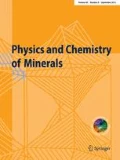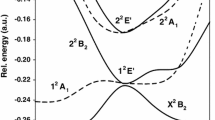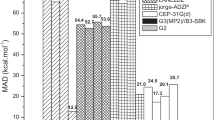Abstract
G2 theory calculations were performed on [H3SiO4]−, H4SiO4, [H3AlO4]2−, [H4AlO4]−, and [H5AlO4]. Molecular structures, atomic charges, and infrared spectra at the HF/6-31G* and MP2/6-31G* levels are compared. The influence of polarization and diffuse functions on the structure of [H3SiO4]− is also examined. Basis set and electron correlation effects on potential energies are assessed by comparing various levels of theory. Proton affinities of these gas-phase molecules and related mineral surface species are predicted based on corrections for cluster-size effects.
Similar content being viewed by others
References
Brand HV, Curtiss LA, Iton LE (1993) Ab initio molecular orbital cluster studies of the zeolite ZSM-5. 1. Proton affinities. J Phys Chem 97:12773–12782
Breneman CM, Wiberg KB (1990) Determining atom-centered monopoles from molecular electrostatic potentials — The need for high sampling density in formamide conformational analysis. J Comp Chem 11:361–373
Carlson HA, Nguyen TB, Orozco M, Jorgensen WL (1993) Accuracy of free energies of hydration for organic molecules from 6–31G*-derived partial changes. J Comp Chem 14:1240–1249
Curtiss LA, Raghavachari K, Trucks GW, Pople JA (1991) Gaussian-2 theory for molecular energies of first- and second-row compounds. J Chem Phys 94:7221–7230
Curtiss LA, Carpenter JE, Raghavachari K, Pople JA (1992) Validity of additivity approximations used in Gaussian-2 theory. J Chem Phys 96:9030–9034
Damrauer R, Simon R, Krempp M (1991) Effect of substituents on the gas-phase acidity of silanols. J Am Chem Soc 113:4431–4435
DeAlmeida WB, O'Malley PJ (1991) The vibrational spectrum of H4SiO4 calculated using ab initio molecular orbital methods. J Mol Struct 246:179–184
DeAlmeida WB, O'Malley PJ (1993) Ab initio infrared and Raman spectra of the H3SiO −4 monomeric anionic species. Vib Spectr 5:325–335
Dowty E (1993) Atoms: A computer program for displaying atomic structures. Kingsport, TN
Foresman JB, Frisch AE (1993) Exploring chemistry with electronic structure methods: A guide to using Gaussian. Gaussian Inc., Pittsburg PA, p 269
Frisch MJ, Trucks GW, Head-Gordon M, Gill PMW, Wong MW, Foresman JB, Johnson BG, Schlegel HB, Robb MA, Replogle ES, Gomperts R, Andres JL, Raghavachari K, Binkley JS, Gonzalec C, Martin RL, Fox DJ, Defrees DJ, Baker J, Stewart JJP, Pople JA (1992) Gaussian 92 Revision C. Gaussian, Inc. Pittsburg PA
Glendening ED, Reed AE, Carpenter JE, Weinhold F (1992) NBO Version 3.1
Hehre WJ, Radom L, Schleyer PR, Pople JA (1986) Ab initio molecular orbital theory. Wiley, New York
Hess AC, McMillan PF, O'Keeffe M (1987) Ab initio force field of the S4 conformation of H4SiO4. J Phys Chem 91:1395–1396
Kim SK, Mhin BJ, Choi U-S, Lee K (1992) Ab initio studies of the water dimer using large basis sets: The structure and thermodynamic energies. J Chem Phys 97:6649–6662
Kiss T, Atkari K, Jezowski-Bojczuk M, DeCock P (1993) Complexes of Al(III) with hydroxyaromatic ligands. J Coord Chem 29:81–96
Kubicki JD, Apitz SE, Blake GA (1995) Ab initio calculations on Si4+ and Al3+ Q3 species: Implications for atomic structures of mineral surfaces and dissolution mechanisms of feldspars. Am Mineral, submitted
Lasaga AC (1992) Ab initio methods in mineral surface reactions. Rev Geophys 30:269–303
Lias S, Bartmess JE, Liebman JF, Holmes JL, Levine RD, Mallard WG (1988) J Phys Chem Ref Data 17. Suppl 1
Lide DR (1992) CRC Handbook of Chemistry and Physics. CRC Press, Ann Arbor MI
Møller C, Plesset MS (1934) Note on an approximation treatment for many-electron systems. Phys Rev 46:618–622
Mulliken RS (1955a) Electronic population analysis on LCAOMO molecular wave functions. I. J Chem Phys 23:1833–1840
Mulliken RS (1955b) Electronic population analysis on LCAOMO molecular wave functions. II. Overlap populations, bond orders, and covalent bond energies. J Chem Phys 23:1841–1846
Newton MD, Gibbs GV (1980) Ab initio calculated geometries and charge distributions for H4SiO4 and H6Si2O7 compared with experimental values for silicates and siloxanes. Phys Chem Minerals 6:221–246
Paukshtis EA, Yurchenko EN (1983) Use of IR spectroscopy in studies of acid-basic properties of heterogeneous catalysts. Usp Khim 52:426–454
Pelmenschikov AG, Morosi G, Gamba A (1992) Quantum chemical molecular models of oxides. 3. The mechanism of water interaction with the terminal OH group of silica. J Phys Chem 96:7422–7424
Pople JA, Schlegel HB, Krishnan R, Defrees DJ, Binkley JS, Frisch MJ, Whiteside RA, Hout RF, Hehre WJ (1981) Molecular-orbital studies of vibrational frequencies. Int J Quant Chem: Quant Chem Symp 15:269–278
Pople JA, Head-Gordon M, Fox DJ, Raghavachari K, Curtiss LA (1989) Gaussian-1 theory — A general procedure for prediction of molecular energies. J Chem Phys 90:5622–5629
Reed AE, Curtiss LA, Weinhold F (1988) Intermolecular interactions from a natural bond orbital, donor-acceptor viewpoint. Chem Rev 88:899–926
Sauer J, Ahlrichs R (1990) Gas phase acidities and molecular geometries of H3SiOH, H3COH, and H2O. J Chem Phys 93:2575–2583
Sauer J, Hill JR (1994) The acidity of surface silanol groups — A theoretical estimate based on ab-initio calculations on a model surface. Chem P Lett 218:333–337
Schindler PW, Stumm W (1987) The surface chemistry of oxides, hydroxides, and oxide minerals. In: Aquatic surface chemistry — chemical processes at the particle-water interface. Wiley, New York, 83–110
Stöber W (1967) Formation of silicic acid in aqueous suspensions of different silica modifications. In: Equilibrium concepts in natural water systems. Advances in Chemistry Series, Am Chem Soc 67:161–182
Ugliengo P, Saunders V, Garrone E (1990) Silanol as a model for the free hydroxyl of amorphous silica: Ab initio calculations of the interaction with water. J Phys Chem 94:2260–2267
Wiberg KB, Hadad CM, Lepage TJ, Breneman CM, Frisch MJ (1992) Analysis of the effect of electron correlation on charge density distributions. J Phys Chem 96:671–679
Author information
Authors and Affiliations
Rights and permissions
About this article
Cite this article
Kubicki, J.D., Apitz, S.E. & Blake, G.A. G2 theory calculations on [H3SiO4]−, [H4]SiO4], [H3AlO4]2−, [H4AlO4]− and [H5AlO4]: Basis set and electron correlation effects on molecular structures, atomic charges, infrared spectra, and potential energies. Phys Chem Minerals 22, 481–488 (1995). https://doi.org/10.1007/BF00209373
Received:
Revised:
Accepted:
Issue Date:
DOI: https://doi.org/10.1007/BF00209373




